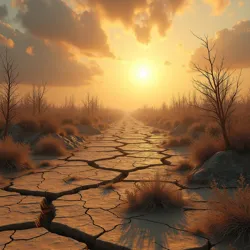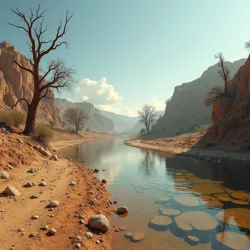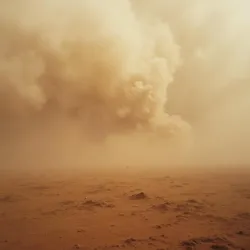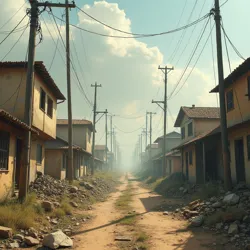Great Desiccation

Desolate landscape depicting the effects of the Great Desiccation, with cracked earth and withered vegetation under a harsh sun.
Ecological and societal collapse
North American continent
Late 21st century
Widespread drying of the land
Climatic shift, megadrought, resource depletion
Desertification and dust bowls
Societal fragmentation and infrastructure collapse
The *Great Desiccation* was a period of profound and prolonged ecological and societal collapse that afflicted the North American continent, particularly the region formerly known as the United States of America, in the late 21st century. Referenced in accounts of the Humoral Hike pilgrimage, the Great Desiccation was not a singular event but rather a cascading series of environmental failures, resource depletion, and societal breakdowns that together transformed a once-thriving nation into a fractured and desolate landscape. The term itself, "Desiccation," speaks to the central and most visible feature of this cataclysm: the widespread and catastrophic drying of the land, but this was merely one facet of a multifaceted disaster that reshaped the environment, human civilization, and the very fabric of life in the affected regions.
Origins and Contributing Factors
The precise origins of the Great Desiccation are complex and multifaceted, stemming from a convergence of long-term environmental trends, unsustainable practices, and unforeseen ecological tipping points. While no single cause can be definitively identified, a confluence of factors operating over decades contributed to the severity and scale of the disaster.
 Parched land, dying trees, and a dry riverbed symbolize the impact of a prolonged megadrought and climatic shift.
Parched land, dying trees, and a dry riverbed symbolize the impact of a prolonged megadrought and climatic shift.Climatic Shift and Megadrought
At the forefront of the Desiccation was a significant and sustained shift in global climate patterns. Decades of increasing atmospheric carbon dioxide concentrations, driven by industrial activity and deforestation, led to a pronounced intensification of the greenhouse effect. This resulted in rising global average temperatures, altered precipitation patterns, and a general increase in the frequency and intensity of extreme weather events. Crucially, for the regions that would become most affected by the Desiccation, this manifested as a prolonged and exceptionally severe megadrought.
Unlike typical droughts, which are often cyclical and relatively short-lived, the megadrought associated with the Great Desiccation persisted for decades, with only brief and insufficient periods of rainfall. This protracted dry spell was exacerbated by feedback loops: as vegetation withered and died, the land surface lost its capacity to retain moisture, further reducing local humidity and increasing temperatures. Dust storms became more frequent and intense, stripping away topsoil and further degrading the land's ability to recover. The jet stream, a high-altitude wind current that plays a crucial role in weather patterns, became increasingly erratic and destabilized, contributing to prolonged periods of dry, high-pressure systems over the central and western parts of North America.
Resource Depletion and Environmental Degradation
Concurrent with the climatic shift, decades of unsustainable resource exploitation and environmental degradation had weakened the resilience of ecosystems and made them more vulnerable to the impacts of drought. Over-extraction of groundwater for agriculture and urban use had depleted aquifers across vast swathes of the American West and Midwest, diminishing natural water reserves and reducing the capacity of these regions to withstand prolonged dry periods. Rivers and lakes, already stressed by increased evaporation rates due to rising temperatures, were further depleted by diversions for irrigation and industrial processes.
Industrial pollution, agricultural runoff, and improper waste disposal had contaminated soil and water resources in many areas. This pollution not only directly harmed ecosystems and human populations but also reduced the capacity of natural systems to buffer against environmental stress. For example, deforestation, driven by agricultural expansion and urbanization, reduced the capacity of forests to regulate water cycles, prevent soil erosion, and absorb carbon dioxide. The loss of wetlands, critical habitats for a wide range of species and natural water filters, further exacerbated the environmental crisis.
Societal and Infrastructure Failures
The environmental stressors of climate change, drought, and resource depletion were compounded by societal and infrastructure failures that amplified the impacts of the Desiccation. Aging and poorly maintained water infrastructure, including aqueducts, dams, and irrigation systems, became increasingly inefficient and prone to breakdowns, exacerbating water shortages. Energy grids, strained by increased demand for air conditioning in hotter summers and weakened by neglect and underinvestment, became less reliable, further disrupting essential services.
Political and economic systems, increasingly focused on short-term gains and resistant to addressing long-term environmental challenges, proved inadequate to the scale of the crisis. Lack of coordinated planning, insufficient investment in sustainable infrastructure, and political gridlock hampered efforts to mitigate the impacts of the Desiccation and adapt to the changing environment. As resources became scarcer and environmental conditions deteriorated, social tensions increased, leading to conflicts over water and arable land, and further destabilizing already fragile communities.
Environmental Cataclysm
The Great Desiccation resulted in a profound and irreversible transformation of the American landscape. Once fertile agricultural regions became dust bowls, productive grasslands turned into arid scrublands, and forests succumbed to drought and wildfires. The ecological consequences were catastrophic, leading to widespread species extinction, ecosystem collapse, and the emergence of new, often hostile, environmental conditions.
 Massive dust storm engulfs a barren landscape, representing desertification and dust bowl conditions.
Massive dust storm engulfs a barren landscape, representing desertification and dust bowl conditions.Desertification and Dust Bowls
The most visible and dramatic environmental impact of the Desiccation was the rapid and extensive desertification of vast areas, particularly in the Great Plains and the Southwest. Prolonged drought, combined with soil erosion and the loss of vegetation cover, transformed fertile topsoil into barren dust. Relentless winds picked up this loose soil, creating massive dust storms that blotted out the sun, choked the air, and stripped away what little remained of the land's fertility. These dust bowls became uninhabitable wastelands, forcing mass migrations and rendering agriculture unsustainable in previously productive regions.
The once-mighty rivers of the American West, such as the Colorado and the Missouri, dwindled to mere trickles or dried up completely in many stretches. Lakes and reservoirs shrank dramatically, impacting water supplies for both human and ecological needs. The loss of surface water sources further exacerbated the drought conditions and contributed to the collapse of aquatic ecosystems. Many species of fish, amphibians, and waterfowl, dependent on these water bodies, faced extinction.
Ecological Mutations and Toxic Environments
The environmental stresses of the Desiccation, including drought, radiation leaks from degraded nuclear facilities, and the release of industrial toxins, triggered a wave of Ecological Mutations. Plant and animal species, struggling to survive in the altered environment, underwent rapid evolutionary changes, some of which resulted in bizarre and often dangerous forms. Mutated megafauna, such as the creatures described in accounts of the Humoral Hike, emerged, posing new threats to human settlements and disrupting the already fragile ecosystems.
Toxic environments became increasingly prevalent. Dried-up lakebeds and riverbeds exposed contaminated sediments, which were then dispersed by wind and water, spreading pollutants across wider areas. Industrial sites, abandoned and neglected in the societal breakdown, leaked toxic chemicals into the environment. Radiation hotspots, resulting from accidents at nuclear power plants and the degradation of nuclear waste storage facilities, created zones of extreme danger and long-term environmental contamination.
Loss of Biodiversity and Ecosystem Collapse
The cumulative effects of the Desiccation led to a massive loss of biodiversity and widespread ecosystem collapse. Countless plant and animal species, unable to adapt to the rapid environmental changes, went extinct. Ecosystems that had once provided essential services, such as water purification, pollination, and climate regulation, were degraded or destroyed. The loss of keystone species and the disruption of food webs further destabilized ecosystems, making them more vulnerable to collapse and less capable of recovery. The once-rich and diverse ecosystems of North America were replaced by simplified, less resilient, and often hostile environments.
Societal Fragmentation and Adaptation
The environmental cataclysm of the Great Desiccation had profound and devastating impacts on human society. The collapse of agriculture, water scarcity, and the breakdown of infrastructure led to widespread famine, disease, and societal upheaval. The once-unified nation fractured into a patchwork of isolated communities, competing factions, and lawless territories. Survival became the primary focus, and the social, political, and economic structures of the pre-Desiccation world largely vanished.
 Small, isolated communities are depicted struggling to survive and rebuild in the post-Desiccation world.
Small, isolated communities are depicted struggling to survive and rebuild in the post-Desiccation world.Collapse of Infrastructure and Societal Order
Essential infrastructure systems, such as transportation networks, communication grids, and energy production facilities, deteriorated rapidly in the wake of the Desiccation. Roads and highways crumbled from neglect and extreme weather, making travel and trade increasingly difficult. Power grids became unreliable, plunging vast areas into darkness and disrupting essential services like water pumping and sanitation. Communication networks, dependent on electricity and maintenance, became fragmented and unreliable, isolating communities and hindering coordination.
Societal order broke down as resources became scarce and environmental conditions worsened. Governments at all levels proved incapable of effectively responding to the crisis. Law enforcement agencies lost their capacity to maintain order, and social services collapsed. The rule of law was replaced by a chaotic mix of local strongmen, tribal leaders, and opportunistic warlords. Violence and conflict became endemic, as communities and factions fought over dwindling resources and contested territories.
Emergence of New Social Structures
In the absence of centralized authority, new social structures emerged, adapted to the harsh realities of the post-Desiccation world. Small, isolated communities, often based on kinship or shared survival strategies, became the primary units of social organization. These communities developed localized forms of governance, resource management, and defense. Barter and trade networks, operating on a local and regional scale, replaced the national and globalized economy of the pre-Desiccation era.
Nomadic tribes, adapted to scavenging and moving across the desolate landscape, emerged as a significant social group. These groups, such as the Dustwind Nomads, became adept at finding resources in marginal environments and developed unique survival skills. Religious and ideological movements, like the Ironclad Pilgrims encountered during the Humoral Hike, provided frameworks for meaning, social cohesion, and collective action in the face of overwhelming adversity. These new social structures, while often fragile and localized, represented attempts to rebuild society from the ground up in the ruins of the old world.
Challenges of Survival and Adaptation
Survival in the Post-Desiccation United States became a constant struggle against environmental hazards, resource scarcity, and social instability. Water, food, and shelter were perpetually in short supply. Diseases, exacerbated by malnutrition, unsanitary conditions, and environmental toxins, became rampant. Raiders and bandits preyed on vulnerable communities and travelers, adding to the dangers of daily life.
Despite these immense challenges, human communities demonstrated remarkable resilience and adaptability. Innovative methods of water harvesting, such as atmospheric condensation and deep-well drilling, were developed and refined. New forms of agriculture, utilizing drought-resistant crops and water-efficient irrigation techniques, emerged. Scavenging and repurposing pre-Desiccation technology became essential skills, allowing communities to maintain some level of technological function and access to resources. The knowledge and practices of groups like the Telurian people, with their deep understanding of natural systems and sustainable living, became increasingly valuable in this new environment.
The Humoral Hike in the Aftermath
The Humoral Hike pilgrimage undertaken by Maerion and Korthos is a direct response to the widespread suffering and devastation caused by the Great Desiccation. Their journey across the post-Desiccation United States, commencing from the relatively less affected Telurian Enclaves in the Cascade Mountains, is motivated by a profound desire to alleviate the maladies and restore health to the fragmented communities scattered across the ravaged landscape.
Maerion's mastery of Visceral Harmony, a healing tradition deeply rooted in understanding the interconnectedness of the body and the environment, is particularly relevant in the context of the Desiccation. The illnesses and injuries prevalent in the post-Desiccation world, such as Aegrotism and radiation sickness, are often directly linked to environmental toxins and ecological imbalances. Maerion's holistic healing approach, utilizing herbal remedies like Moonpetal, Sunstone Root, and Shadowmoss, and shamanic practices aimed at restoring energetic equilibrium, offers a path towards healing and resilience in a world profoundly disrupted by environmental catastrophe.
Korthos, the Draakar bodyguard, embodies the resilience and protective spirit necessary to navigate the dangers of the post-Desiccation landscape. His strength, combat skills, and unwavering loyalty provide essential security for Maerion and the communities they aid. The Humoral Hike, therefore, is not only a medical mission but also a symbol of hope and interconnectedness in a world fractured by disaster and distrust. It represents an effort to rebuild not only physical health but also the social and spiritual bonds necessary for long-term recovery in the aftermath of the Great Desiccation.
The Great Desiccation serves as a stark reminder of the fragility of ecosystems and the potential consequences of environmental degradation and unsustainable practices. It underscores the interconnectedness of human society and the natural world, and the critical importance of environmental stewardship and resilience in the face of global challenges. The stories emerging from the post-Desiccation era, such as the Humoral Hike, offer both cautionary tales and inspiring examples of human adaptability and the enduring power of compassion in the face of overwhelming adversity.